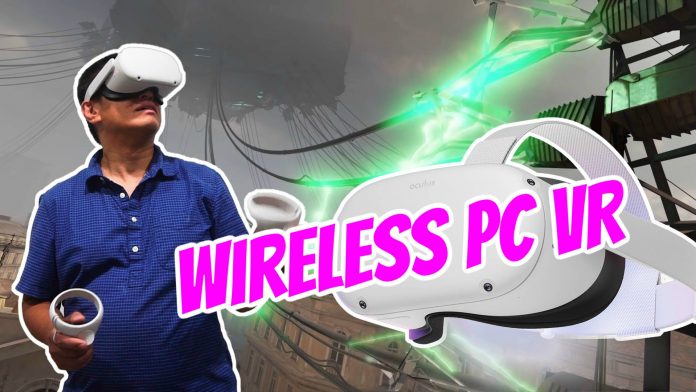L’articolo è riportato dal sito collegato al link che state leggendo. Clic per collegarsi al sito originale.
Clic to view the source link
Is the $299 Oculus Quest 2 a good VR headset for PC VR (desktop VR)? How does it compare to Oculus Rift S? In this post, I’ll discuss how well Quest 2 works for PC VR. I’ll also show how to put together a VR-ready PC for the lowest cost, and how to set it up for both wired and wireless VR gameplay, using Oculus Link or Virtual Desktop.
Table of Contents:
Background and Executive Summary
Oculus Quest 2 vs Rift S vs Quest comparison
Minimum PC requirements for Oculus Link and Virtual Desktop
Oculus Quest 2 Oculus Link FAQ
How to use Oculus Quest 2 Oculus Link to play PC VR
How to Oculus Quest 2 Oculus Virtual Desktop to play PC VR wirelessly
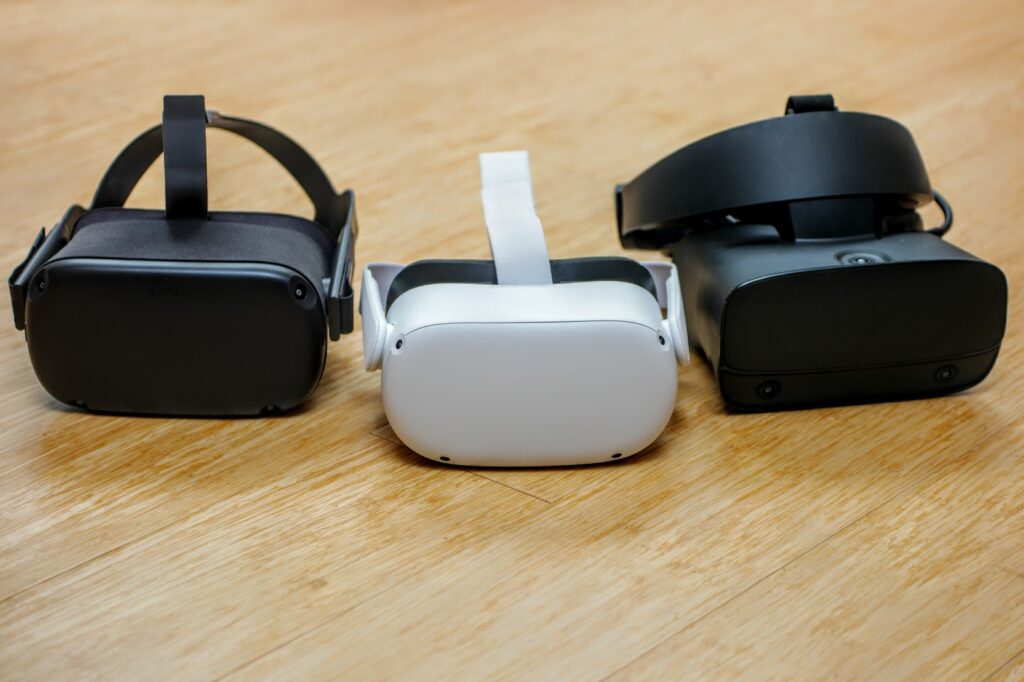
BACKGROUND AND EXECUTIVE SUMMARY
Oculus Quest 2 is a standalone 6DOF mobile VR headset. It doesn’t need to be tethered to a PC and doesn’t have any external sensors. Instead, it uses four cameras on the headset for inside out tracking using computer vision. Quest 2 is the second 6DOF mobile VR headset from Oculus and improves on the original Quest with a faster processor, higher resolution screen, larger storage options, and a significantly lower price.
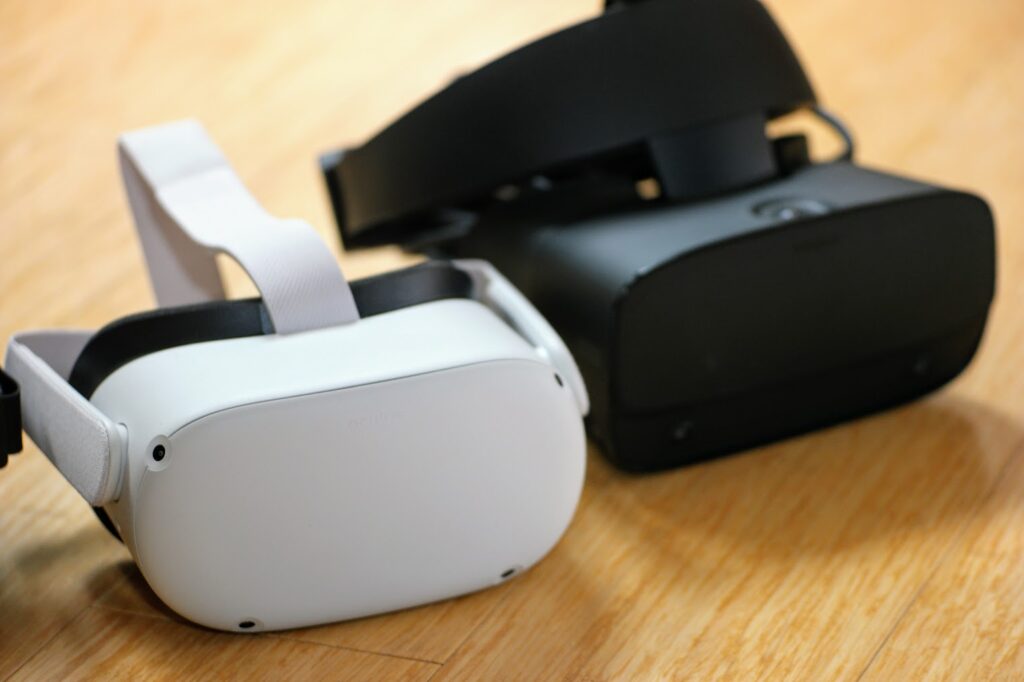
Rift S is a desktop VR headset. Unlike its predecessor — the Oculus Rift CV1 — the Rift S has no external sensors, which makes it much more convenient to use. It has five cameras for inside out tracking.
Although Quest and Quest 2 were designed as mobile VR headsets, they can also be used for PC VR. But how well do they work compared to a desktop VR headset, such as Oculus Rift S? It may seem that using Quest for PC VR was only an afterthought and therefore it wouldn’t be that good for desktop VR. But the truth is that Quest and Quest 2 are pretty good for desktop VR as well. I have several mobile and desktop VR headsets and I was surprised that Quest 2 can be almost as good as Rift S for PC VR gaming, although it does have drawbacks.
Rift S key advantages and disadvantages over Quest 2 for PC VR:
+ sharper compared to Quest 2 when Quest 2 is being used for PC VR
+ hand tracking has wider range because of extra cameras on the side of the headset.
+ slightly smoother motion in complex scenes on modest PC hardware (GTX 1070), i.e. no dropped frames.
+ halo-style strap is more comfortable than the Quest 2’s fabric strap
+ USB cable is less likely to be accidentally disconnected
– can’t be used wirelessly
– needs USB and HDMI ports
– IPD adjustment is software only
Available for $399.
Oculus Quest 2’s key advantages over Rift S for PC VR:
+ you can play PC VR games wirelessly (additional setup required)
+ much better audio quality
+ costs less than Rift S
+ can be used as a standalone mobile VR headset
– When using Oculus Link, it is less detailed than Rift S
Available for $299 64GB or $399 256GB.
Oculus Quest 1’s key advantages over Rift S for PC VR:
+ you can play PC VR games wirelessly (additional setup required)
+ more comfortable headstrap than either Quest 2 or Rift S, in my opinion
+ better contrast and black levels than either Quest 2 or Rift S
+ better audio quality
+ can be used as a standalone mobile VR headset
– When using Oculus Link, it is less detailed than Rift S
– When using Virtual Desktop, it has a slight moire pattern.
Availability: discontinued.
BOTTOM LINE
For PC VR with the absolute best detail, smoothest motion, lowest latency, and best hand-tracking, I would recommend Rift S ($399). If you’re ok with slightly less detail for versatility, wireless gaming, and the ability to use it for mobile VR, go for Quest 2 ($299 64GB or $399 256GB).
OCULUS QUEST 2 VS RIFT S VS QUEST COMPARISON
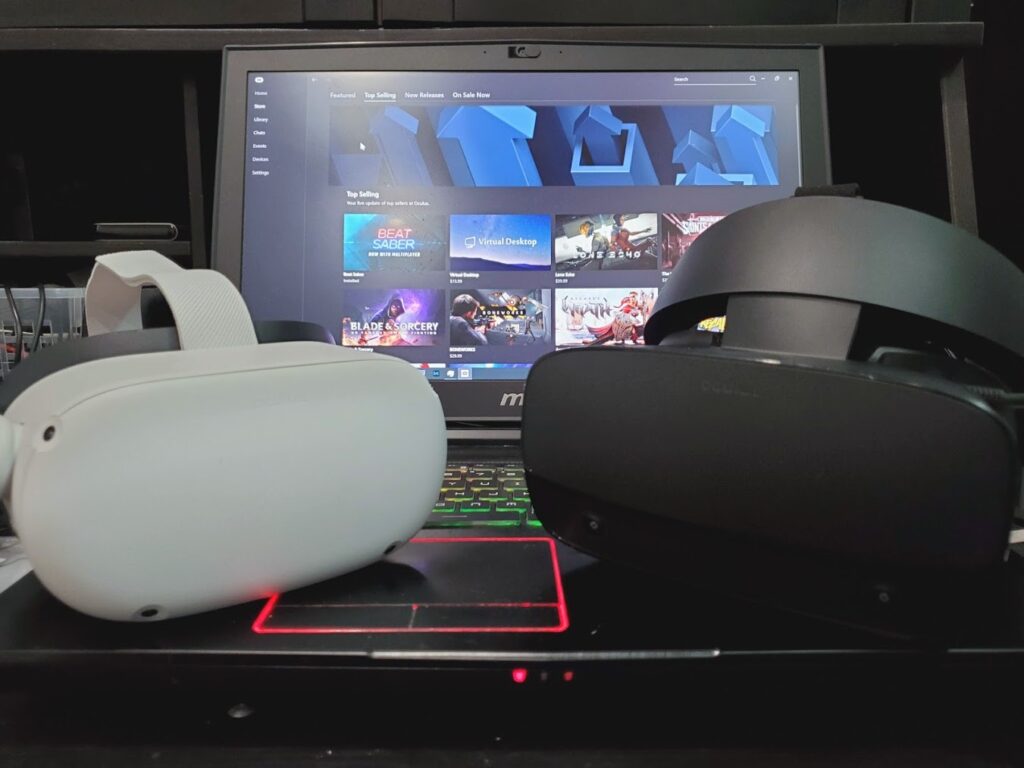
Detail: When using Quest 2 by itself, it has exceptional detail. It is more detailed than Quest or Rift S, which are themselves among the more detailed VR headsets. With Quest 2, there is almost no screendoor effect (you won’t see the individual pixels or spaces between them). However, when Quest 2 is used with Oculus Link to play PC VR games, then it appears a little less detailed than Rift S, as if there was a slight blur, but is still sufficiently detailed.
Black levels and contrast: Both Quest 2 and Rift S use LCD screens (unlike the Quest which uses OLED) and have similar black levels. In ordinary scenes, the Quest 2 and Rift S contrast is not noticeably worse than that of the Quest 1. However, in dark scenes, such as dungeons or caves, you’ll notice the blacks appear dark gray even without comparing it to Quest 1. With Quest 1, blacks consistently appear black.
Godrays: Quest 2, Quest 1 and Rift S all have some godrays, although it’s not as bad as 1st generation headsets such as the Oculus Rift CV1. Note: godrays are the glow that you can see around objects when they are in a dark background.
IPD: Quest has full adjustment from 58mm to 72mm. Quest 2 has limited adjustment of three positions: 58mm, 63mm and 68mm. Rift S has a fixed IPD of 63.5mm, although its software can simulate IPD adjustment, up to a point.
Comfort: Rift S has a halo-style strap with a pad that allows some of the weight to rest on your forehead. For a majority of users, it is more comfortable than Quest 2’s fabric strap. However, Quest 2 does have an optional halo-style Elite Strap that has similar comfort. All three are front heavy and I experience strain on the back of my neck after using them for around 30 minutes. However, when I use a counterweight such as a battery, then there’s no issue.
Tracking: headset tracking is accurate for all three. For hand tracking, Rift S is a little more accurate than Quest 1 or Quest 2 for tracking hand movements on the side. All three do a good job of tracking hand movements near the face.
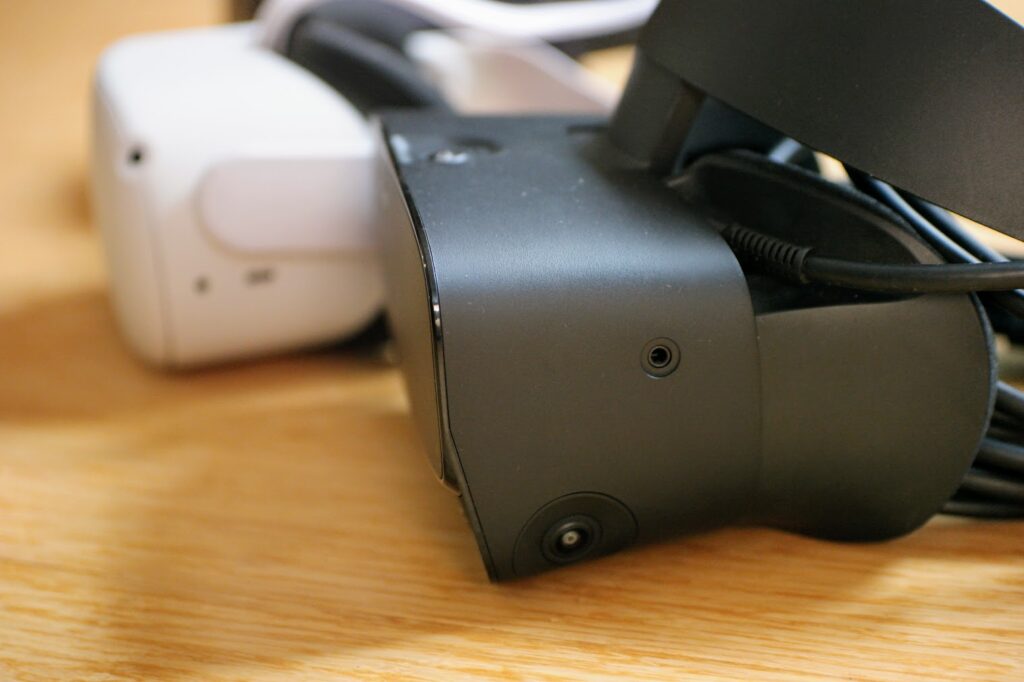
MINIMUM PC REQUIREMENTS FOR OCULUS LINK AND VIRTUAL DESKTOP
When you are using Oculus Quest 2 to play PC VR with Oculus Link or Virtual Desktop, your PC has to not only play the VR game, but also has to stream it at the same time to the Quest, therefore it will require a more powerful graphics card. See the list of compatible cards here. As of 2020, the most affordable graphics card that can work with Oculus Link is GTX 1650 Super (not just a GTX 1650). Please note that unlike the GTX 1650, a GTX 1650 Super card will require a 6-pin power connector.
- Intel i5-4590 or better
- 8GB RAM or more
- GTX 1650 Super or better
- USB 3.0 port.
The cheapest and probably also the easiest way to get a PC that meets these specs is to get a used PC with i5-4590 or better, 8GB RAM or more, with Windows 10. I suggest looking for one with a tower case. A PC with small form factor can use only half-height PCI cards and the fastest low profile graphics card is the GTX 1650, which is not sufficient to run Oculus Link.
Can a laptop run Oculus Link? Yes. My laptop with GTX 1070 can run Oculus Link or even wireless Virtual Desktop. It is possible for a reasonably-priced laptop to support Oculus Link. As of October 2020, I’m not aware of a laptop with a GTX 1650 Super. However, there are several laptops that have GTX 1660, such as this one with i5 10th gen and 16GB RAM and 512GB SSD or this one with 32GB RAM and 1TB SSD.
FAQ
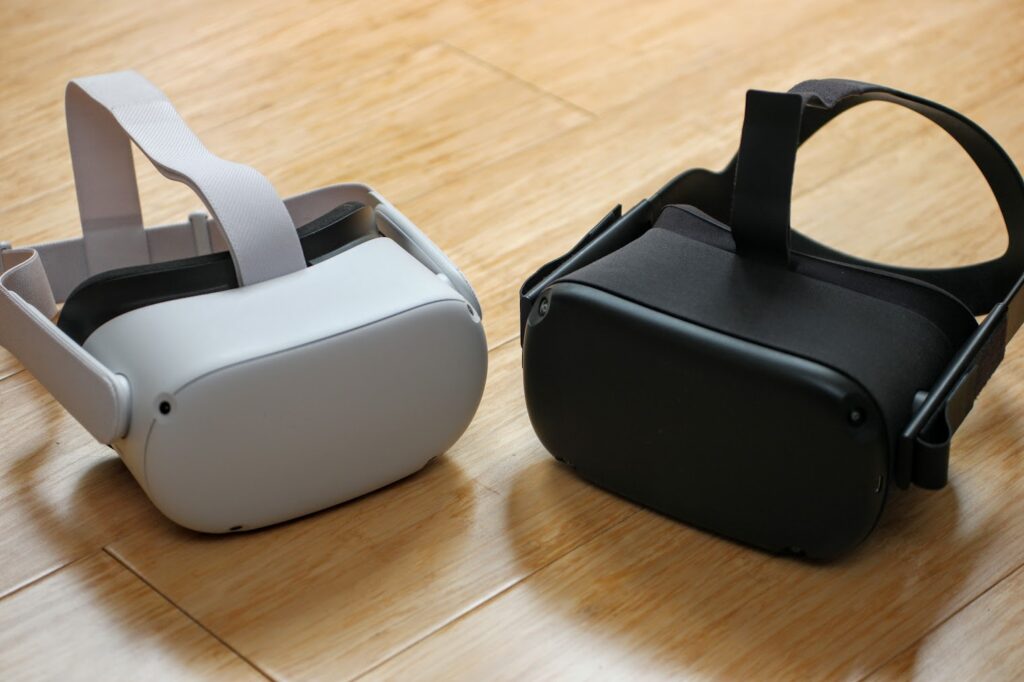
- I’ve never tried VR. What’s the difference between VR and 3D? What’s it like?
See this related post - How do I know if my PC can use Oculus Quest 2 or Rift S?
– The minimum processor as of 2020 is Intel i3-6100 (Rift S) or Intel i5-4590 (Quest 2). Recommended is Intel i5-4590 or better.
– The minimum RAM is 8GB.
– The minimum graphics card is GTX 1050 Ti (Rift S) or GTX 1650 Super (Quest 2 Oculus Link). Recommended is GTX 1060 (or AMD RX 480) or better.
– Both Rift S and Quest 2 need a USB 3.0 port. In addition, Rift S also requires an HDMI port. - Is a VR-Ready PC expensive? How much is a VR-ready PC in 2020?
No. It is possible to buy a system for $400 or less. Get a used tower PC with i5-4590 or better, 8GB or more RAM, and Windows 10 installed. On eBay this should be under $250. Make sure it has at least one PCI slot available.
Next, install a compatible graphics card. If the graphics card needs a power cable, then you’ll need to connect a power cable from the PC’s power supply to the graphics card. The most powerful graphics card that does not need a power cable as of 2020 is the GTX 1650. It can run Rift S, but is below the minimum for Oculus Link. - Can a $400 PC really run VR?
Yes. In fact, in 2020, it’s possible to get a VR-ready PC for even less. Here is a demo with an i5-4590, 8GB, and GTX 1050Ti low profile (with Oculus Rift CV1): - Can a laptop run desktop VR? Can it use Rift S? How about Oculus Link?
Yes it can. I use VR with my laptop all the time. The tricky part is that some graphics cards work differently on a laptop. For example, the GTX 1050 Ti is enough to run desktop VR. However, on most laptops with GTX 1050 Ti, the HDMI port is not connected to the graphics card. As a result, Oculus Rift S won’t work on most laptops with GTX 1050 Ti. Another example is that GTX 1060M (for laptops) is not enough for Oculus Link, while GTX 1060 on desktop is enough for Oculus Link.
The bottom line is that for laptops, the minimum is GTX 1660 for Oculus Link or GTX 1650 for Rift S. - Can a Mac run Oculus desktop VR?
Sorry, no. - Do you need the Oculus Link cable for Oculus Link to work?
Not necessarily. To use Oculus Link, you do need a fast USB cable. Oculus sells a 16-ft Oculus Link fiber optic USB 3.0 cable for $79. Please note it is USB Type C to Type C, so you’ll need a USB Type C port or an adapter. As an alternative, Oculus also recommends this 10-ft Anker cable which is just $18. The Anker is shorter but it costs much less and it is a USB Type C to Type A cable, so it is easier to find an available port for it. Moreover, in my tests, I found my Anker USB cable to be faster than my Oculus Link cable (although the Oculus Link cable is longer). Another advantage of the Anker cable is that it seems to be easier for compatibility. I tried the Oculus Link cable and it didn’t work on my Quest 2 but worked on my Quest 1. Meanwhile, the Anker cable worked for both. - Does the Quest 2 battery run down when using it for Oculus Link?
No. In fact, the battery charges when connected via Oculus Link. - Can Quest 2 play Oculus desktop VR games? How about Steam VR games?
Yes, Quest 2 can play Oculus desktop VR games and Steam VR games via Oculus Link or Virtual Desktop. I’ve tested even graphically demanding games such as Half-Life: Alyx and it worked. - Are there games that are not compatible with Virtual Desktop?
Some games are compatible with Virtual Desktop only if purchased from Steam store or from Oculus store. See this list. - How do you exit Oculus Link and go back to the regular Oculus Quest 2 screen?
From the Oculus Home settings, select “Disable Link.” - I tried Virtual Desktop but it says “headset not found.”
Be sure to launch the games from within the Quest’s Virtual Desktop app. Don’t launch them from Oculus desktop app. If you’re still getting an error, try to reinstall Steam VR first, then reinstall Virtual Desktop Streamer.
How to Use OCULUS QUEST 2 OCULUS LINK for PC VR
Using Oculus Quest 2 to play PC VR is very simple as long as you have a PC with the minimum requirements (see FAQ#2 above) and a compatible cable (Oculus Link cable for $79 or Anker cable for $18).
- First, launch the Oculus app on your PC.
- Next, plug the USB cable to connect your Quest or Quest 2 to your PC’s USB 3.0 port.
- On your Quest headset, you should see a message asking if you want to enable Oculus Link. Confirm that you want to enable it. Alternatively, you can go to Quest 2’s settings and select Oculus Link.
When you enable Oculus Link, the Oculus Home view in your headset will change to the same Oculus Home that you would see on Rift S. You can then launch any game and play it as you normally would. If you want to exit Oculus Link, go to the Settings and click on Disable Link.
Can Oculus Quest 2 play Steam VR games with Oculus Link? Yes, absolutely. As long as you’ve installed Steam and SteamVR, you should see Steam VR among your Oculus apps. From Oculus Home, run the Steam VR app, which will launch the Steam VR Home. From there, you can launch Steam VR apps. I’ve run even graphically demanding games such as Half-Life: Alyx.
How to Use OCULUS QUEST 2 for WIRELESS PC VR
Quest 2 can not only be used for PC VR games and apps but it can even do so wirelessly through an app called Virtual Desktop. The graphics slightly less detailed than Oculus Link but is fairly smooth and has no noticeable lag. The disadvantage is that it takes several steps, although each step is fairly simple.
What you need
You’ll need a more powerful PC (see above), a 5ghz wireless router, and an ethernet cable from your PC to your router. You’ll also need four software:
– sidequest (a PC app for sideloading apps into Quest or Go)
– Virtual Desktop for Oculus Quest (available on the Oculus Store)
– Virtual Desktop Patch (available on Sidequest)
– Virtual Desktop Streamer for PC
How to install:
Step 0: Install Oculus app, Steam, and SteamVR (available on Steam) on your PC if you haven’t done so yet.
Step 1: Purchase and install Virtual Desktop for Oculus Quest on your headset.
Step 2: Install Virtual Desktop Streamer on your PC https://www.vrdesktop.net/ Make sure to install Steam VR first before you install virtual desktop streamer.
Step 3: Install Sidequest.
- Install Sidequest on PC (sidequestvr.com)
– Create an Oculus developer account (developer.oculus.com)
– Download ADB (Android Debug Bridge) driver. Available on Oculus after you create a developer account.
– Unzip and install ADB driver on your PC - Enable Developer mode on your Quest. From your Oculus phone app, connect to your Quest, tap on the down arrow and choose More Settings… and toggle Developer mode on, then reboot your headset (hold down the power button until it turns off).
– Connect your Quest to your PC via USB cable.
– On your Quest, you’ll see a popup asking if you want to allow debugging. Choose yes.
Step 4: On SideQuest, look for Virtual Desktop and Run the Virtual Desktop Patch. After the patch is installed, disconnect the USB cable from your Quest 2.
Bonus: now that you have Sidequest, you may install other unofficial apps available on Sidequest if you wish.
How to use Virtual Desktop wirelessly:
After following the steps above, you are now ready to use Virtual Desktop wirelessly.
– Connect your PC to your router via ethernet cable
– Run Virtual Desktop Streamer on your PC.
– From Oculus Quest, run the Virtual Desktop app. Under Settings, use the highest bitrate.
– On the left margin of the Virtual Desktop app, choose Games. Your Oculus desktop VR and Steam VR games will be listed here. Just click on the game to launch it. Please note some games take a long while to load (a few minutes).
If you encounter a “Headset not found” error, try these:
– Reboot your PC.
– Reinstall Steam VR
– Reinstall Virtual Desktop Streamer.
If you have a 5ghz router but your connection is less than 866 mbps, try rebooting your headset and launching again.
Conclusion:
For PC VR, Rift S is a little sharper and more crisp than Quest 2 in Oculus Link or Virtual Desktop. However, most users will find that Quest 2 is generally about as good as Rift S for desktop VR as long as your PC is powerful enough. Quest 2 also makes it possible to play desktop VR games wirelessly. The downside is that Quest 2 takes many steps to install, and during use, it is more likely to have occasional glitches such as sound becoming out of sync, or the video freezing momentarily.
If you’re a PC gamer who wants the best detail, smoothest motion, and lowest latency, I recommend Rift S. On the other hand, if you want a more versatile headset or if you want a wireless VR experience for greater immersiveness (at the expense of a little detail and motion that is a bit less smooth), then go for Quest 2.
The post Better for PC VR? Oculus Quest 2 vs Rift S (plus Oculus Link and wireless PC VR tutorial) appeared first on 360 Rumors.


